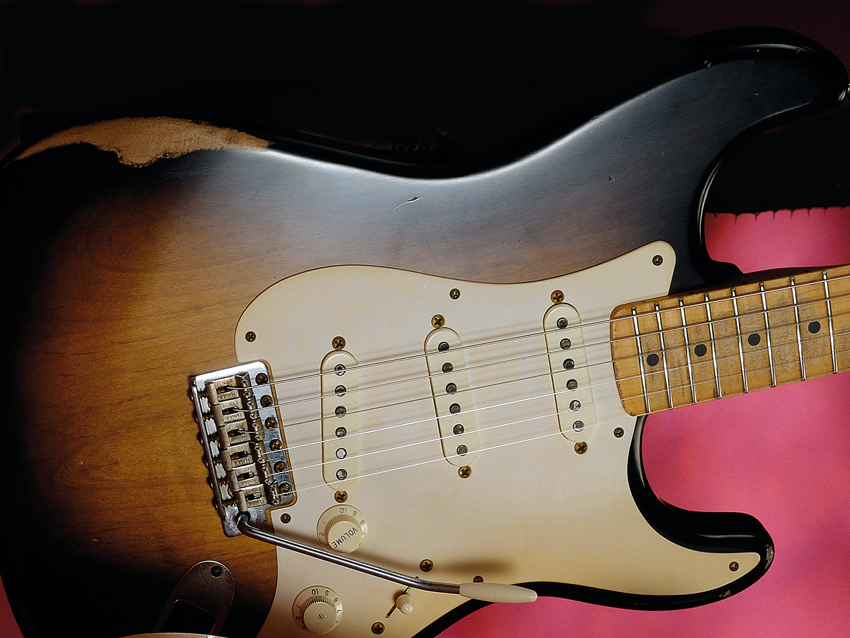MusicRadar Verdict
Quite simply a great Strat. It looks and feels like it's already had a life and is ready for much more.
Pros
- +
Old look, feel and vibe. Very balanced vintage-y tones. Improved playability.
Cons
- -
A little more meat to the neck wouldn't go amiss. Ageing contrived in places.
MusicRadar's got your back
This writer has yet to file a two-word guitar review but in this case it got close. What two words? Buy this! It really is that simple.
Vintage Fender Stratocasters, Teles, P or Jazz Basses, have to be among the most lusted after instruments for any guitar player. Yet escalating prices, not to mention the question of authenticity, have put many of us off.
Fender's so-called Time Machine Series brought the illusion of a vintage Fender to many more people: a high quality guitar, as close to the real thing as you could get, without the worry about authenticity or insurance - you could keep your real one in a bank vault and gig the NOS, Closet Classic or Relic and only you would know. The trouble with that, however, is that for many of us £2k plus is still a lot of cash.
"There's a lot of dirty raw wood - and a great fret job."
We got an inkling, however, that Fender was gearing up to do something about this dilemma when it launched the Joe Strummer Telecaster last year - the first, more affordable Mexican-made guitar that was aged and distressed.
We heard more rumours that the Mexican workforce were taking all sorts of implements to their usually finely finished guitars. At the end of 2008 we were let in on the secret: Fender had been working on a mini-range of 'Road Worn' guitars, Mexican Relics to you or us. The wait is over.
'50s Strat

It's possibly due to the stronger contrast between the black edge of this Strat's two-tone 'burst against its alder body but, compared to its blonde-on-ash Telecaster sibling, it looks more heavily aged and because of that, slightly contrived.
But if you like that more bashed about and abused look then it'll be love at first sight. From a few paces it really does look accurate, although it'll never fool a vintage expert.
Want all the hottest music and gear news, reviews, deals, features and more, direct to your inbox? Sign up here.
But that's not what this series is about: it's about that special vibe that an old, used guitar imparts and overall it captures it very well, especially with the nicely aged neck - there's a lot of dirty raw wood - and a great fret job.
Profile-wise the neck goes for quite a pronounced 'V' and the reduction in the shoulder does tell your hand it feels skinnier than it actually is. There certainly might be players who'd prefer a little more meat.
The metal parts are convincingly aged; likewise the plastic parts, although the first tone control does look a little over done.
Thankfully, unlike certain Custom Shop Time Machine guitars, we don't have the old-style three-way pickup selector; the five-way is a much better idea although, as on the original circuit, neither tone control is connected to the bridge pickup.
Sounds
If the look and feel of the guitar is old and worn, the sound is a little less specific, which might have vintage guitar forums buzzing but for the majority of players the pickup choice and the overall sounds are eminently useable.
There's plenty of twang and bite to the bridge pickup, the neck is thicker and creamier yet with oodles of high-end sparkle and the middle pickup is - as it should be - a well-balanced halfway house.
It's not vintage accurate, but those classic in-between sounds from the five-way lever switch are such an intrinsic part of the Strat's arsenal that it would have been daft to fit this with a three-way switch. The mix of a solid, balanced pickup set with some 'old guitar' resonance makes it hard to put down.
That 'which-to-buy' quandary is, of course, balanced by the price: you could buy this along with the '50s Tele and '60s Strat for the price of one Custom Shop Relic. And while the latter, depending on model, might be more vintage-accurate with more subtle ageing, higher spec wood and hardware and USA-made pickups, to be honest Fender might really have shot itself in the foot here.
Not all of us can justify the necessary £2k plus on a Relic, however much we want one, but aside from the most professional of situations we feel these Road Worns are going to be the answer for most of us mortals struggling through the credit crunch.
And don't forget, Teles and Strats are the easiest guitars in the world to mod: you could easily swap hardware or pickups if you want to be more vintage specific or if you feel those Costalot 'boutique' pickups are really worth it.
But our advice would be to live with what you have here, at least for a while. Yes, we've played Strats that are lighter/ heavier, have bigger/slimmer necks, are darker/brighter and so on but Fender has achieved a very balanced tonality here that few players should object to. In short, these are genuinely very, very good guitars.
Dave Burrluck is one of the world’s most experienced guitar journalists, who started writing back in the '80s for International Musician and Recording World, co-founded The Guitar Magazine and has been the Gear Reviews Editor of Guitarist magazine for the past two decades. Along the way, Dave has been the sole author of The PRS Guitar Book and The Player's Guide to Guitar Maintenance as well as contributing to numerous other books on the electric guitar. Dave is an active gigging and recording musician and still finds time to make, repair and mod guitars, not least for Guitarist’s The Mod Squad.

